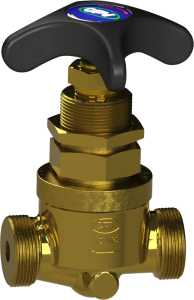Selecting the Right Flow Control Valve: A Guide for Operators
Water flows, winds flow, and manufacturers prefer flow production, a term to describe the smooth and orderly movement of materials and components through the facility. The flow production method promotes efficient, streamlined output, and that means all components and systems must work in concert to achieve these efficiencies.
Flow control valves, although small components, are mighty in terms of keeping production flowing smoothly in chemical processing and other industry segments, as they regulate and direct the flow of liquids, gases, or slurries through piping systems, preventing disruptions and maintaining optimal process conditions.
Some of the most common industries that regulate gas flow for example, in addition to chemical processing, includes the food and beverage sector, pharmaceutical and biotechnology applications, water/wastewater management, oil and gas, industrial gas, and the energy and power industry.
At the heart of any well-designed system is a minor yet critical component—the flow control valve. Flow control valves not only control the flow, as the name implies, but also the volume, direction, rate, and pressure of fluids and gases. As such, the flow control valve impacts the plant’s safety and efficiency, its production and profitability.
However, selecting the appropriate flow control valve can pose a complex and challenging task due to the need to balance multiple, often competing system requirements and operating conditions. This selection of a seemingly simple component is complex due to:
- The multiple factors requiring consideration, such as flow rate, pressure, fluid properties, control characteristics.
- System-specific needs that might require a tailored valve solution.
- Potential for unintended and undesirable consequences from an improper selection.
- Technical expertise required to properly evaluate and size the valve.
- Evolving system conditions over time.
The flow control valve needs to be carefully matched to the unique and sometimes changing demands of the fluid system. All the relevant specifications and known or anticipated operating conditions must be considered and balanced to select a valve for the most reliable, efficient and safe operation.
Properly sizing and matching the valve
As an operator, the biggest hurdle when choosing a flow control valve is selecting the proper size and matching it to specific system requirements. The wrong selection could generate many issues – from insufficient flow capacity to excessive pressure drops, control instability to premature wear and reliability problems. Carefully evaluate the key factors to select the proper flow control valve for optimal performance and long, trouble-free service life, for a true “set it and forget it” component.
- Determine your flow requirements The first and most fundamental step is to accurately define your flow requirements. This means knowing the minimum, maximum and ideal flow rates you need the valve to handle. Consider not just your current needs, but any potential future changes or expansions to your system. Underestimating your flow requirements can lead to an undersized valve unable to meet your process demands. Conversely, overestimating can result in an oversized valve that creates excessive pressure drops and control challenges.
- Evaluate fluid properties The physical properties of the fluid flowing through the valve can impact valve selection and performance. Factors like fluid viscosity, density, temperature and phase (liquid, gas, or two-phase) must be considered.
More viscous or dense fluids will require larger valve sizes to maintain the same flow rates as less viscous fluids. The potential for issues like cavitation and flashing must also be carefully evaluated based on the fluid’s vapor pressure characteristics.
- Assess pressure requirements Closely related to a system’s flow requirements are the pressure conditions. Operators should know the upstream and downstream pressures and the maximum allowable pressure drop across the valve. These pressure parameters will help dictate the valve size, trim and actuator needed to provide the required flow control while maintaining suitable pressure conditions. Ignoring pressure requirements can lead to control instability, component damage and safety hazards.
- Factor in valve sizing and materials With the flow, pressure and control parameters defined, you can begin sizing the valve. This requires careful hydraulic or pneumatic calculations, computerized flow modeling, and close collaboration with the valve manufacturer like CPV Manufacturing.
The right valve size is critical – too small and you will restrict flow, too large and you will battle instability and cavitation. The valve materials of construction must also be compatible with your process fluids to ensure long-term reliability and avoid corrosion or erosion issues.
- Do not forget installation and maintenance Even the most carefully selected valve can underperform if the installation and maintenance practices are suboptimal. Factors like upstream and downstream pipe configurations, valve orientation, and accessibility for servicing must all be considered during the installation phase. Ongoing monitoring, adjustment and preventative maintenance are also essential to keep your flow control valve operating at peak efficiency throughout its service life.
The consequences of getting it wrong
Selecting the wrong flow control valve for your application can have serious consequences. An undersized valve will be unable to meet your flow demands, potentially starving critical equipment and disrupting your entire process. An oversized valve, on the other hand, can create excessive pressure drops, control instability, and cavitation-induced damage. Both scenarios can lead to reduced efficiency, higher energy consumption and compromised system reliability.
Partnering for success
Given the complexity involved, operators are well-advised to work closely with experienced valve manufacturers and distributors when selecting flow control valves. Their technical expertise, application knowledge and sizing tools can be invaluable in ensuring you choose the right valve for your specific needs. Do not be afraid to lean on their guidance – it could mean the difference between a smoothly running, reliable fluid system and one plagued by persistent control and performance issues.
CPV Manufacturing focuses its efforts on fabricating and supplying high-quality valves, fittings and supplemental equipment for demanding applications like the naval and aeronautics industries. CPV can offer tailored solutions crafted with care, or more standard valves in a wide range of sizes.
By partnering with our experienced team of engineers, we can collaborate with your team to select and meet your unique requirements for reliable, precise flow control of industrial gases or liquids. Learn more about our extensive product line of valves and fittings. Or speak to a member of our staff to discuss the specifications for your next project.
Be thorough in your analysis and do not hesitate to seek expert support. Get the valve selection right, and you will enjoy trouble-free operation and optimal performance from your fluid system for years to come.

